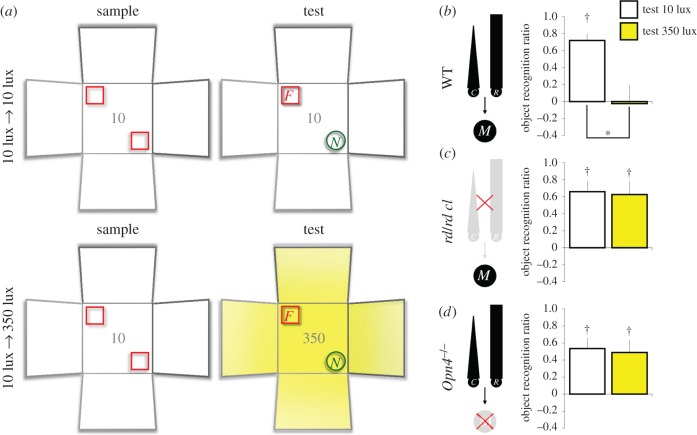Figure 2.
The modulatory effect of light on test performance depends on both rods/cones and melanopsin (sample phases at 10 lux). The background irradiance was manipulated at test (10 or 350 lux) but the visual context remained unchanged (white arena). (a) Schematic shows the spontaneous object recognition task under the 10 lux → 10 lux and 10 lux → 350 lux conditions. In both conditions, a mouse was allowed to explore two identical replicates of an object (indicated by red squares) in the white arena for 10 min in the sample phase. After a 5 min delay, a novel object (indicated by green circles) was introduced and the animal was allowed to explore the familiar and novel objects for 2 min in the test phase. For animals in the 10 lux → 10 lux condition, both the sample and test phases were performed under 10 lux, measured at the centre of the white arena. For animals in the 10 lux → 350 lux condition, the light level in the test phase was increased to 350 lux. All other aspects of the task were identical under the two conditions. (b–d) Object recognition ratios in WT mice, rd/rd cl, and Opn4−/− mice, respectively. Performance in WT mice was sensitive to the background light level. Recognition ratios were higher when the test was given at 10 lux than when it was given at 350 lux (n = 22 in the 10-lux test; n = 12 in the 350-lux test; (b)). No effect of light on performance was found in rd/rd cl and Opn4−/− mice (n = 8 per light condition in rd/rd cl mice; n = 6 per light condition in Opn4−/− mice mice; (c,d)); however, both genotypes could discriminate between novel and familiar objects. In the diagrams in (b–d), R/C, rods/cones; M, melanopsin-expressing pRGCs; asterisk: significant effect of test irradiance (p < 0.005); dagger = significant object recognition performance (above zero; p < 0.05); error bars denote standard error of mean.

